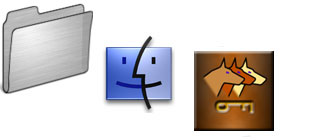 ![[Header]](../XuShared2/Line3.jpeg)

(Up to OJB's Mac Tips List Page)
Change Prefs using TerminalMac OS X has a flexible settings and preferences management system which makes it easy to configure the computer the way you want. Most of the important settings for applications can be set in the application's preferences, and many system level settings can be set in the System Preferences, but there are many more than this that can only be changes using more obscure methods!
Because Mac OS X is built on top of Unix, many features can be accessed through the Unix terminal. The terminal is a program which allows the user to type commands instead of using the graphical interface most Mac users are used to. The Terminal program is in the Utilities folder, inside the Applications folder. Note that the terminal gives you access to hundreds of incredibly powerful utilities, but with great power comes great danger! With a few keystrokes terminal can erase every file on your disk, so be careful!
There is a Unix utility called "defaults" which allows setting preferences from the command line which aren't usually available from the graphical interface. The commands below show some of the things it can do. Remember to type things exactly as shown, or better copy them from this page and paste them into terminal. if you are unsure about a command don't use it! I am not responsible for any problems that result!
Drag and Drop Delay
Many people have problems dragging and dropping text in Cocoa applications (many modern Mac OS X programs are written using Cocoa, for example Mail and Safari). The reason this happens is that the dragger (ie the user) must highlight the text, then click on it and hold the button down with the mouse still for 1 second (an eternity), and then drag the text. Older Carbon programs (eg Eudora) have a shorter delay so the problem doesn't seem to happen.
The answer, of course, is to reduce the delay, with: defaults write -g NSDragAndDropTextDelay -int 100
The number on the end is the required delay in milliseconds (so the command above sets the delay to 1/10th second). Type (or copy and paste, or drag and drop!) this command in the terminal. Programs only change after they are restarted. You don't need to restart the computer.
Change Location of Screen Capture Files
By default, when you take a snapshot of the screen, using command-shift-3 or command-shift-4, a file is created on your desktop. This tends to clutter it a bit and it is often useful to save them somewhere else.By using the defaults command you can specify a path to the location you want the files saved into.
Here's the command: defaults write com.apple.screencapture location /Users/owen/Documents
Of course, you will need to change the path (unless you happen to have a user called "owen"). Create the folder (if it doesn't already exist) before making the change. The path must also be complete, so you cannot specify a path based on the user's home folder (using ~) or a relative path. To activate the change log out and log back in again. if you have spaces in the name of a folder in the path you will need to use "\" to prefix it, For exmaple, if you have a folder called "Screen Shots" in your home folder use: /Users/username/Screen\ Shots.
You can also change the type of graphics files that the screen capture program generates. if you don't find the default, PDF, very useful try this command.
Use this to change to JPEG: defaults write com.apple.screencapture type jpg
![[Up]](../XuShared/Up2B.jpeg)
|

![[Up]](../XuShared/Up2B.jpeg)